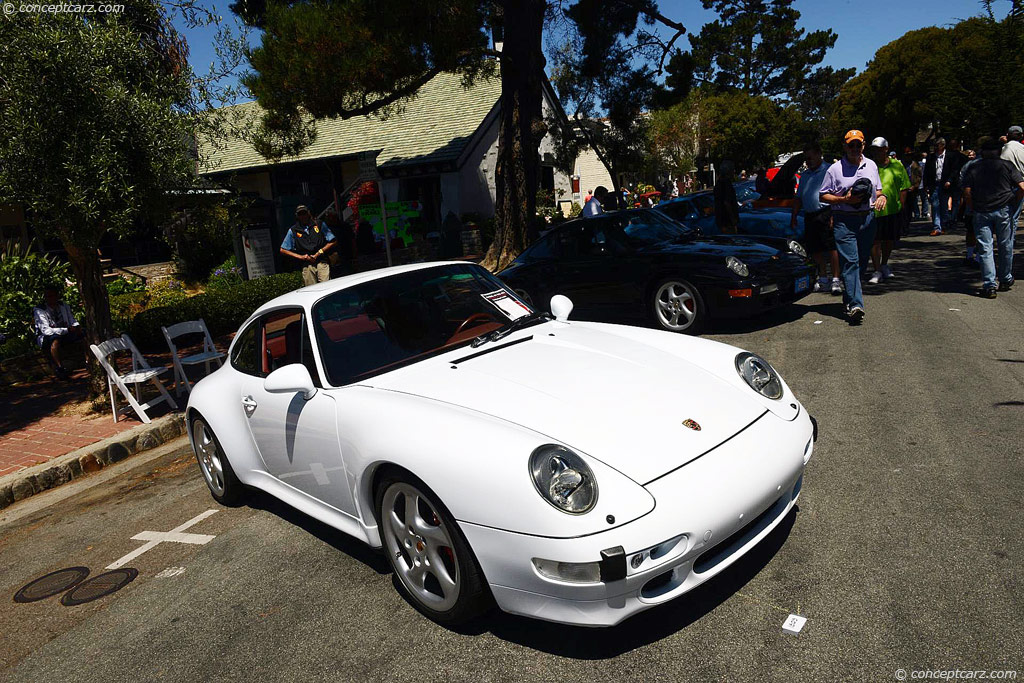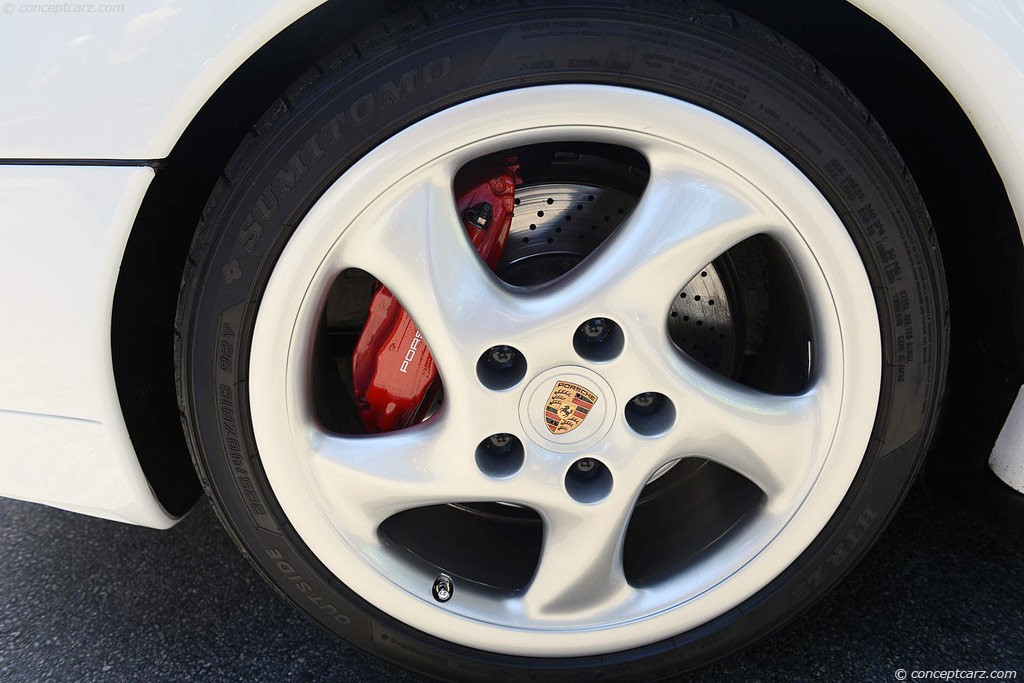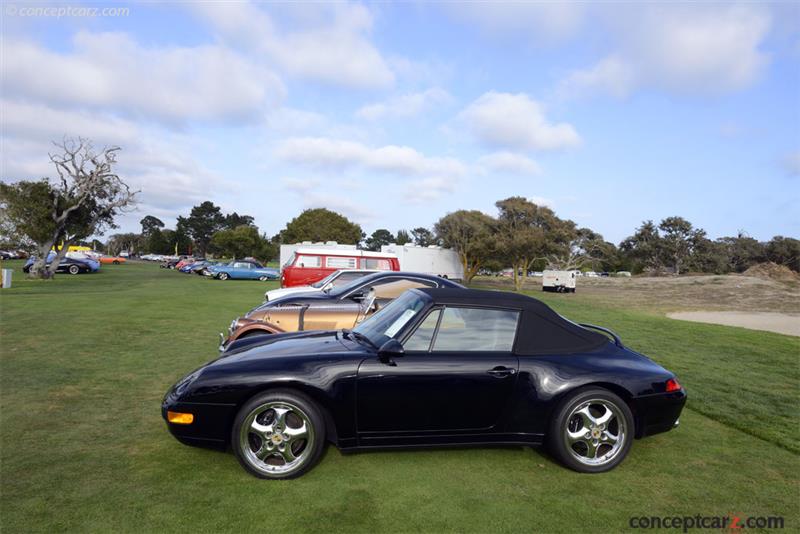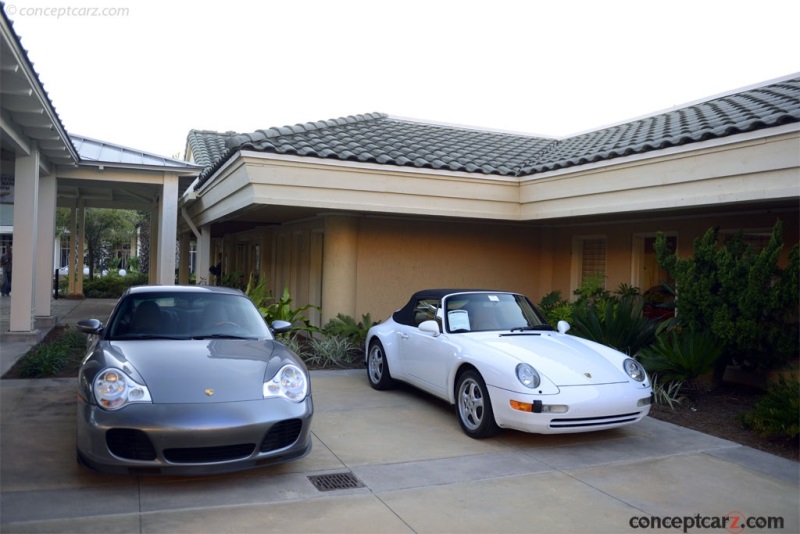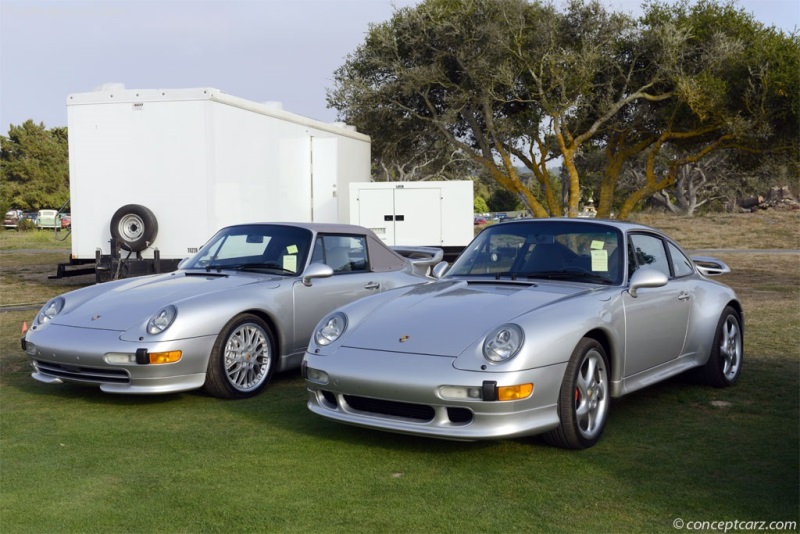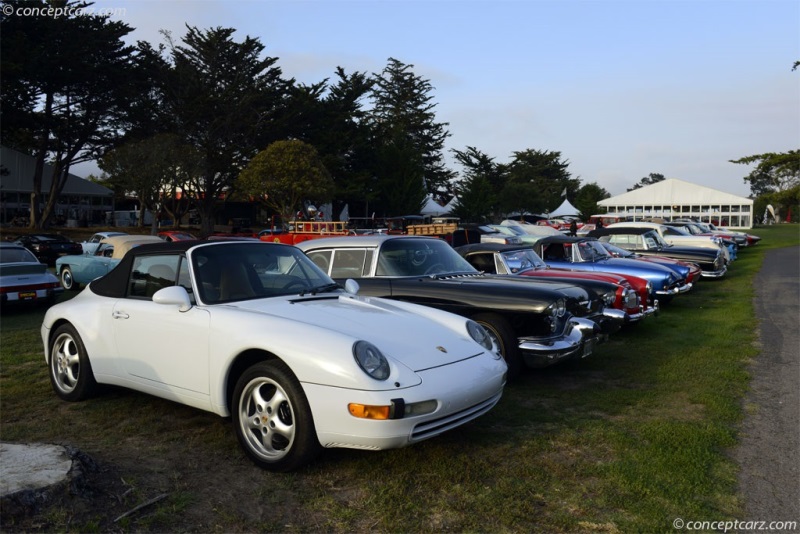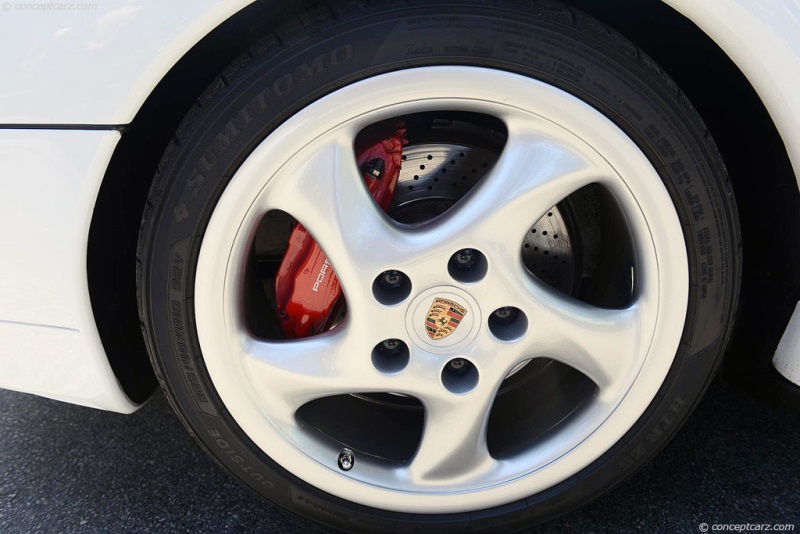The Porsche 911, internally designated as the 993, was built between 1993 and 1998 and was the last air-cooled Porsche produced. Emissions and output requirements meant that the the 911 generation that followed the 993, the 996, would need to be water-cooled, and necessarily a completely different design.The Porsche 993 wore styling by a 35-year-old Englishman named Tony Hatter, a graduate of London's Royal College of Art. Design inspiration for its front styling was sourced from the canceled 965 twin turbo. The remainder of the car had fluid styling that was wider and more muscular with flared fenders that suggested better handling and more power.The Type 993 was almost entirely new when it debuted in 1994, with a revised power steering system, larger brakes with drilled discs, a new dual-flow exhaust system, and the rear suspension featured an all-alloy multi-link setup attached to the new all-alloy sub frame. The wheelbase measured 89.4 inches, stood 51.6 inches tall, and had an overall length of 167.7 inches. The 3.6-liter flat-6 was also new, incorporating single overhead cams with hydraulic self-adjusting (the first in a 911), new twin plug heads, and improved breathing to produce 272 horsepower at 6,100 RPM. While the Type 964 was offered with a four- or five-speed transmission, the 993 was the first generation of the 911 to have a six-speed manual transmission included as standard. The rear-wheel-drive Carrera, Carrera S, Targa, and Cabriolet could be optioned with a 'Tiptronic' four-speed automatic transmission, first introduced in the 964. The Tiptronic S became available for the 1995 model year and added wheel-mounted controls, and its software improvements resulted in quicker and smooth shifts. The all-wheel-drive system had a center differential with a viscous coupling unit, unlike the three differentials used by the 964's AWD setup. Rear-wheel-drive models were commonly referred to as 'C2' or 'Carrera 2' while the all-wheel-drive versions were known as the 'C4' or 'Carrera 4'. The C4 had an automatic braking differential and was visually distinguishable by clear front and side turn indicators and rear red turn indicators. They wore a Carrera 4 badge on the engine cover, a Carrera 4 logo was on the center wheel caps, and the brake calipers were painted silver. The Tiptronic was not offered on the Carrera 4.The Cabriolet body style was introduced alongside the coupe in April of 1994 for the 1995 model year and both were offered with all-wheel drive. The cabriolet had a small spoiler mounted with the third braking light, and a fully electrical and hand-sticked soft top reinforced with metal sheets and an automatic wind blocker. The Targa body style arrived in 1996 and had a retractable glass roof that retracted underneath the rear window, and rode on unique two-piece 17-inch wheels.The Porsche 993 Turbo and Turbo SThe 993 Turbo coupe was released in 1995 and its twin K16 turbocharged 3.6-liter engine produced 402 horsepower. It had redesigned cylinder heads, an electronic engine management system, air-to-air intercoolers, bigger brakes, a wide body with wider tires, new 18-inch alloy wheels with hollow spokes, and a sculpted spoiler tail with downturned edges. Zero-to-sixty mph took 3.7 seconds and had a top speed of 180 mph. Additionally, it was one of the first production cars in the world to be equipped with an OBDII diagnostics system. One of the most exciting and desirable models of the 993 generation was the Turbo S, and represented a significant improvement in both performance and price over the Turbo. It was priced 50 percent higher than the standard Turbo, and its 3,605cc air-cooled flat-six engine with twin turbochargers and electronic fuel injection allowed it to sprint from zero-to-sixty mph in 3.6 seconds, and could hit the 100 mph mark in 8.9 seconds, a half-second faster than the standard Turbo. It had larger Triple K K-24 turbochargers, an additional oil cooler, a modified Motronic engine management system, and produced approximately 450 hp (DIN) (the American market version produced 424 hp (SAE)). Just 345 examples of the Turbo S were built by Porsche's Exclusive Department and they came fitted with several unique features not offered on other 911s of its generation. They wore yellow brake calipers, a unique rear spoiler, an Aerokit front spoiler, an air intake in the rear wings, four exhaust pipes at the rear, and polished five-spoke Turbo S wheels. The interior received carbon-fiber trim to contrast the leather interior.The Porsche 993 Carrera 4S / Carrera SThe Carrera 4 S (with all-wheel-drive) was produced in 1996 and the rear-wheel-drive Carrera S was built in 1997. Both shared the Turbo model's bodyshell, wide rear arches, wide tires, and larger brakes with red calipers, but were equipped with the naturally aspirated engine. The Porsche 993 Carrera RSPorsche created a lightweight version of the Carrera dubbed the Carrera RS and came equipped with the naturally aspirated 3.8-liter engine, dual oil coolers, larger intake valves, a modified Bosch Motronic engine management system, Varioram variable-length intake manifold, and lightweight rocker arms. It was mated to a six-speed G50/31 manual gearbox with modified gear ratios for the first three gears and a limited-slip differential. The cross-drilled and ventilated disc brakes had four-piston calipers residing behind the three-piece 18-inch aluminum wheels. The exterior wore a large fixed rear wing and small front flaps. Weigh-reducing measures included using special racing seats, spartan door cards, reduced use of sound proofing, thinner glass, and the seam-welded body shell had an aluminum bonnet with a single strut. The final weight of the car was approximately 2,820 lbs. The Carrera RS was built in 1995 and 1996 with 1,014 examples built, including 213 Clubsport variants. The Clubsport was a track-oriented version of the Carrera RS and came with a welded roll cage, a large rear wing, a deep chin spoiler, and was devoid of carpeting, air conditioning, a radio, and power windows. Although the Clubsport was road legal in Europe and many other countries, it was not approved for export to the United States.The discontinuation of the Type 993 marked the end of air-cooled Porsches.
by Daniel Vaughan | Oct 2017
by Daniel Vaughan | Oct 2017
Related Reading : Porsche 911 History
The legendary Porsche 911 is the longest production run sports car of all time. It was conceived as a successor for the highly successful Porsche 356 and from the start had high aspirations for success. Ferry Porsches son, Ferdinand Alexander Porsche, designed the 911. When it went into production it was labeled the 901 but Peugeot had claims to the name, so to avoid infringing on their naming scheme,....
Continue Reading >>
Continue Reading >>
Related Reading : Porsche 911 History
Who could predict that the 911 would be Porsches saving grace and surpass the 356 in sales, longevity Quickly establishing itself as an icon of 60s cool, the iconic 911 only became more popular as the years went on. The flagship of the current lineup of Porsche, the 911 (pronounced Nine Eleven) or Neunelfer is a two-door grand tourer with a very distinctive design. The 911 is one of the oldest....
Continue Reading >>
Continue Reading >>
Similar Automakers
1998 Porsche 911 Carrera Vehicle Profiles
Recent Vehicle Additions
Performance and Specification Comparison
Price Comparison
$41,050
Type 993 Specification Comparison by Year
Year
Production
Wheelbase
Engine
Prices
6 cyl., 231.89 CID., 370.00hp
7,152
89.40 in.
6 cyl., 219.70 CID., 282.00hp
6 cyl., 228.60 CID., 300.00hp
6 cyl., 219.75 CID., 400.00hp
6 cyl., 228.60 CID., 300.00hp
6 cyl., 219.75 CID., 400.00hp
$63,800 - $105,050
5,933
89.40 in.
6 cyl., 219.75 CID., 282.00hp
6 cyl., 219.75 CID., 400.00hp
6 cyl., 219.75 CID., 424.00hp
6 cyl., 219.75 CID., 400.00hp
6 cyl., 219.75 CID., 424.00hp
$63,755 - $150,050
Related Automotive News

Acura's Super Rare First SUV Reimagined With Super Handling All-Wheel Drive
Acura to debut restomod SLX luxury-sport utility vehicle – Super Handling SLX at the RADwood celebration of 80s and 90s automotive lifestyle
1st Acura SUV upgraded with brands latest performance tech Acura Super Handling All-Wheel Drive™, a r...

JEEP® AND MOPAR UNVEIL SEVEN CONCEPT VEHICLES BUILT FOR 50TH ANNUAL EASTER JEEP SAFARI
Vehicles Showcase a Wide Variety of Mopar and Jeep Performance Parts
Jeep® Crew Chief 715 a salute to legendary Jeep military service vehicles
Jeep Shortcut inspired by the classic CJ-5 to handle tight, winding trails
Jeep Renegade Comm...

NISSAN ANNOUNCES U.S. PRICING FOR 2015 NISSAN JUKE
NASHVILLE, Tenn. – Nissan announced U.S. pricing for the new 2015 Nissan JUKE sport cross, which features a revised exterior and enhanced standard equipment – plus a new JUKE Color Studio personalization program. The 2015 JUKE goes on sale today...
THE 2015 NISSAN LINEUP: CHARTING THE CHANGES
Nissans U.S. sales have significantly outperformed the industry in 2014, up 12.7 percent CYTD through June. Sales have been led by the recently redesigned Altima, Rogue and Sentra – along with other models such as LEAF (29.4), JUKE (44.9), Frontier...

Pricing Announced For 2014 Toyota Corolla
TORRANCE, Calif., August 27, 2013 - The all-new 2014 Corolla will offer its dramatically elevated design, efficiency and renowned Toyota quality, at an extremely attainable price. The worlds most popular compact sedan will remain a legendary...
